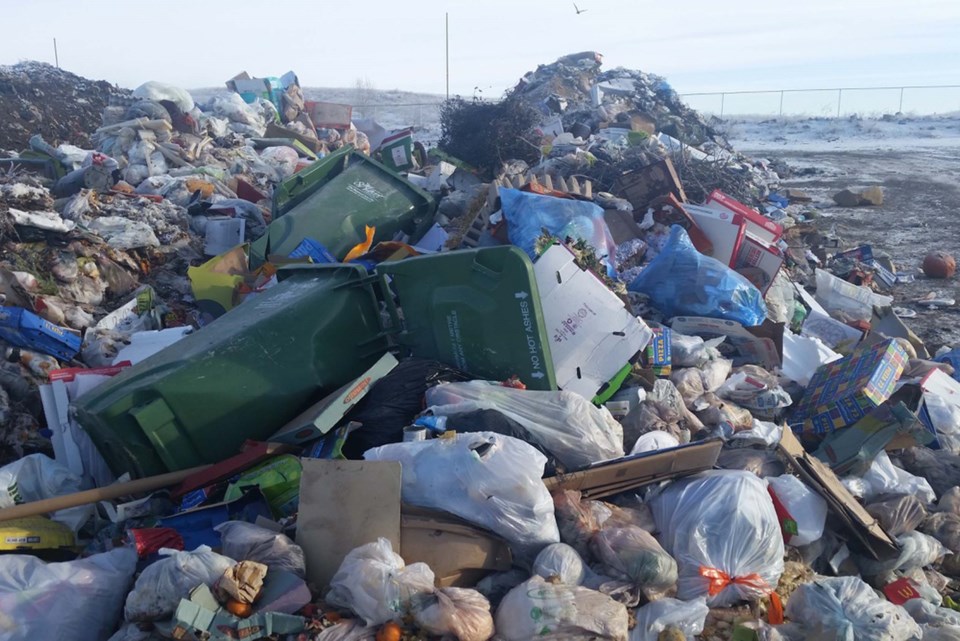City council has called for some green-bin solutions after learning virtually all of St. Albert’s organic waste was sent to the landfill in February.
St. Albert council approved a motion June 7 to have staff bring forward ideas besides curbside education on how to reduce the amount of contamination found in the city’s green-bin program.
St. Albert has had curbside organic waste collection (the green bin) since June 2011. The program aims to keep food and yard waste out of the landfill (where it would become the potent greenhouse gas methane) by diverting it to composting facilities at the Roseridge landfill.
The green-cart program was a great success when it was first introduced, helping the city meet its original 2020 waste-reduction targets eight years ahead of schedule in 2012.
Widespread contamination
Complaints about non-compostable contaminants in the green bins have mounted, however, with the Roseridge Waste Management Services Commission threatening fines over the issue in 2017.
Roseridge flagged the contamination issue again in January 2021, a report to council reads. Contractors were spotting green bins full of garbage, household hazardous waste, recyclables, and textiles at levels far above the 30-per-cent contamination limit set by its contract with St. Albert, with some carts exceeding 50 per cent contamination. One green bin contained an entire toilet, council heard.
Starting June 2021, Roseridge had contractors self-declare on arrival whether their green-bin loads were more than 30-per-cent contaminated. Anything over 30 per cent was land-filled at $52 a tonne, while loads under that threshold were composted at $46 a tonne. Senior public works manager Louise Stewart told council that contractors make this determination visually and are paid the same regardless of contamination levels.
The report said some 41 per cent of St. Albert’s organic waste collected from June 2021 to April 2022 was land-filled due to excessive contamination — that’s some 3,000 tonnes or 500 elephants’ worth of material. An extensive public education campaign last year had little effect, with 97 per cent of the city’s green-bin contents land-filled in February.
In an interview, Roseridge manager Susan Berry said St. Albert was not the worst community she served in terms of green-bin contamination, and that February’s loads may have been anomalous. Some neighbourhoods were also much better at keeping contaminants out of the green bin than others.
Still, Berry said her crews routinely found non-compostable plastic bags in organic waste shipments, as well as fabric, shoes, and propane tanks.
“Some residents are knowingly hiding stuff in their [green] bins,” she added, citing the presence of plastic windshield washer fluid jugs (which are obviously not compostable) in bins as evidence.
Stewart said the most common contaminants in St. Albert’s green bins were black garbage bags (often full of actual garbage), plastic shopping bags (which are becoming less common as stores phase them out), packaged food, and to-go drink cups. Also problematic were “compostable” products which don’t biodegrade in an outdoor compost facility like the one at Roseridge.
Stewart noted that a whole street’s worth of organic waste could end up in the landfill instead of the compost pile if there are just one or two contaminated bins in it.
Coun. Wes Brodhead said it is discouraging to see this level of contamination in the green bins given the city’s efforts to be seen as environmentally conscious.
Time for enforcement?
Stewart said administration is doing a trash audit this year which will determine the amount of contamination present in the city’s recycling, composting, and garbage programs. Administration will come back with recommendations on how to improve all three programs by the end of March 2023, “which would likely include enforcement at this point.”
(While St. Albert can fine residents $100 for putting non-compostable material into a green bin, city waste management manager John Potter told The Gazette the city has yet to issue any such fines.)
Coun. Mike Killick said it is a real shame that two or three “bad apples” could ruin a neighbourhood’s efforts to be good environmental stewards, adding that he was “horrified and dismayed” when council learned of this contamination problem earlier this year.
“There is a direct cost to all residents when a few don’t follow the rules,” he noted, both in terms of higher utility bills and more greenhouse-gas emissions.
While Roseridge is experimenting with additional screening to keep contaminants out of its compost, Berry said asking landfills to solve this contamination problem means more cost to residents.
“If people aren’t willing to sort their waste, it’s going to cost them more for disposal.”
Calgary case study
The City of Calgary has a three-stream curbside waste program very similar St. Albert’s yet has a substantially lower rate of organic-bin contamination: just three to five per cent, Calgary waste and recycling services program manager Sharon Howland said in an interview.
Howland said Calgary has an extensive year-round multilingual education campaign to teach its residents how to sort their trash, one which sees kids tour the city’s composting facility to learn the consequences of improper sorting and crews hang signs on store shelves to indicate which products will actually biodegrade in Calgary’s composting plant.
Calgary trash collectors also do regular spot checks for contamination and will tag and not collect contaminated carts, Howland continued. Crews pull non-compostable items out of carts and stick them to the carts in clear bags to make the problem obvious, and talk directly with residents about trash-sorting problems. In rare cases, bylaw officers levy fines for improper sorting.
Industry research shows successful waste-diversion programs are backed by both education and enforcement, Howland said.
“You either enforce using penalties or you take the cart away.”
Howland said it is also important to tell residents about the consequences of improper waste sorting.
“All that great progress we made over the last 10 years, it’s just in the landfill now.”



